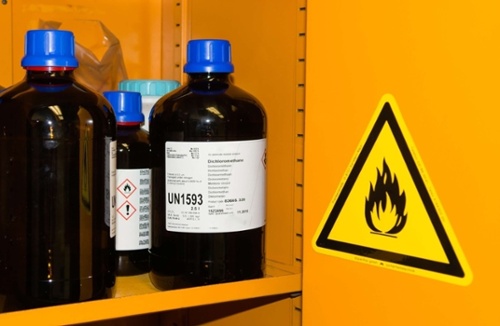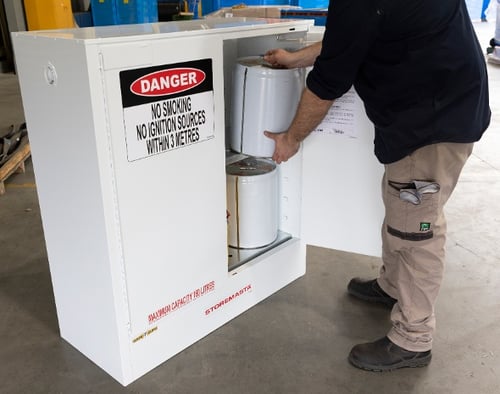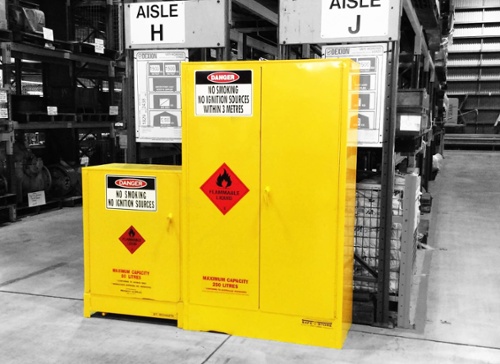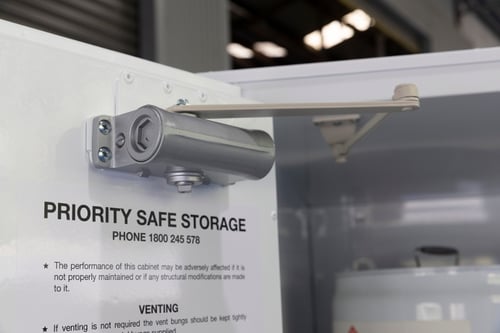Not all door closing systems on your indoor safety cabinets are created equal. The quality, durability and functionality of your safety cabinet door closing system can affect how well your cabinet performs, as well as how long it lasts. The door closing system can also influence how easy it is for staff to operate the storage equipment and successfully reduce chemical hazards.
While all Storemasta indoor safety cabinets are meticulously built to meet the appropriate Australian Standard, what makes our cabinets different is our patented door closing system — known as the SAFE-T-CLOSE® system. To help you understand why this patented door closing system is beneficial for your operations, we’ll be explaining the various chemical hazards that your cabinet (and its doors) control. We’ll also be showing you how other door systems can fail – or not assist staff to properly close up the cabinet when it’s not in use.
REMEMBER: Our SAFE-T-CLOSE® door closing system is 100% Storemasta. You can’t find this door closing system anywhere else. Our system was developed and manufactured in Australia at our Burnie, Tasmania facility to improve safety at your site.
Features of a Compliant Cabinet
When it comes to dangerous goods storage options, there are some key features which are necessary for compliance — and other features which can simply improve the safety and ease at which you can store chemicals onsite.

From the risk of fire to the inhalation of harmful vapours, safety cabinets provide the necessary protection against chemical hazards in the workplace.
The key features that cabinets require for the safe indoor storage of dangerous goods and hazardous substances include:
Spill Containment
To reduce the risk of hazards such as fires (flammable liquids), corrosion (corrosive substances) and human harm (toxic chemicals) etc. Spill containment also prevents physical accidents from occurring onsite, such as slips and falls when chemical leaks and spills are not adequately contained.
Vapour Containment
Many chemical vapours are hazardous for human health, as well as potentially damaging for the surrounding environment. Containing chemicals and their vapour is important for indoor chemical storage.
Security
Some classes of dangerous goods require lockable cabinets for indoor storage. This is to prevent unauthorised entry, which could result in loss of chemical inventory, vandalism or other malicious acts. However, it’s a good idea to have a lockable indoor safety cabinet to protect both your chemical products from theft or misuse — as well as your organisation from the damage that can occur when products aren’t used by trained personnel.
Protection for Contents
Damage to chemical packages within a storage environment can result in financial loss for your business, as well as leaks, spills and other related hazards. Storing products in a durable steel cabinet is essential for organisation, safety and security. Some classes of cabinets, such as flammable solids or liquids, also must be constructed to allow a 10 minute window for evacuation in the event of a workplace fire. This is made possible with the inclusion of a heat (thermic air) barrier within the cabinet’s construction that protects the chemicals from excessive heat.

The construction of the cabinet allows a range of chemical hazards to be controlled.
As you can see, the structure of the cabinet – including the design and construction of the doors – assists in the control of various chemical hazards. The doors assist with providing protection for the contents of the cabinet, allowing the cabinet to be secure. Cabinet doors also help contain harmful vapours, as well as assisting in leak and spill prevention.
Requirements for Safety Cabinet Doors
The Australian Standard for flammable liquids (1940) is arguably one of the most stringent set of requirements for safety cabinet construction. This is due to the range of hazards that flammable liquids pose – to people, property and the environment.
Flammable liquids cabinets must be constructed to meet the following requirements for the doors:
- Indoor flammable cabinet doors must be self-closing and close-fitting
- These doors must be held shut automatically by catches at 2 or more points
The self-closing and close-fitting functionality mentioned in the requirements assists with controlling the hazards associated with flammable vapours, as well as leaks and spills. Having the doors shut automatically prevents staff from accidentally or intentionally leaving the doors open.
While there are other requirements that relate to the doors for various chemical cabinet classes (such as auto release functions to avoid a build up of pressure within the cabinet), it is beneficial for many classes of chemicals to have cabinets that are self-closing, with close-fitting doors.
However, our SAFE-T-CLOSE® door closing system takes this functionality a step further by allowing users to effortlessly close the doors in sequence, without lifting a finger.
REMEMBER: Your safety cabinet can only protect your organisation from harm if it’s being used in the manner in which it was designed for. Never prop open the doors of a cabinet or leave it open, as it can’t control chemical hazards if the unit is not properly closed after the work task is completed.
What is the SAFE-T-STORE® Door Closing System?
Our door closing system allows doors to close automatically and sequentially. The hydraulic-action doors close firmly, but smoothly, which prevents the doors jamming, slamming or generating dangerous sparks (which can ignite some chemicals).
All parts in our door closing system can be easily fixed, as Storemasta offers an extensive parts replacement inventory.

The patented system allows cabinet doors to close in sequence every time.
In addition to the door closing system, our L-handle door fastener is fully lockable, and comes with its own key. If you happen to lose your Storemasta safety cabinet door key, they can also be replaced if you contact us directly.
IMPORTANT: Our sequential door closing system can be easily adjusted to suit your requirements for door closing speed. Staff need only use a screw driver to manually adjust the door closing speed on the chemical cabinet by turning the adjustment screw on the hydraulic door closer.
Storemasta’s sequential door closing system allows cabinet doors to shut in the correct way – every time. This prevents staff closing the doors incorrectly, or not being able to close the doors at all.
Other Safety Cabinet Door Closing Systems
For other manufacturers of dangerous goods storage equipment, the compliant safety cabinet must meet the requirements of the Australian Standards. However, that does not include the sequential door closing solution that Storemasta provides.
The problem with other door closing systems is that the doors often slam shut, causing wear and tear over time. This can affect the longevity of the cabinet and the effectiveness of the self-closing, tight-fitting doors. After weeks, months or years of use, these spring-loaded door closes can fail – which means that your cabinet needs to be replaced or repaired.

Our hydraulic door closers are unique to Storemasta chemical cabinets.
If staff aren’t careful about closing the doors properly, it can affect the stability of the chemical packages within the cabinet. Slamming the cabinet doors can topple stored chemicals, as well as creating a hazard for staff who are working with the cabinet.
Furthermore, as the doors of the safety cabinet are designed to contain leaks, spills and vapours – as well as assist in providing a heat barrier in some circumstances – the functionality and durability of the doors is essential in maintaining the safety of the cabinet.
Lastly, other door closing systems rely heavily on staff to use the system properly. If staff don’t close the doors in the correct sequence – or if they fail to fully release the handle – the cabinet won’t be able to protect the workplace from chemical hazards.
However, with a Storemasta indoor chemical cabinet, our door closing system takes the guesswork out of cabinet operation.
What Storemasta Cabinets Feature this Door Closing System?
Our chemical safety cabinets that feature the SAFE-T-CLOSE® system are designed and manufactured in accordance with the applicable Australian Standard.
Here’s a full list of Storemasta indoor chemical cabinets that feature our patented door closing system:
- Class 3 Flammable Liquids cabinets
- Class 3 Combustible Liquids cabinets
- Class 4.1 Flammable Solids cabinets
- Class 4.2 Spontaneously Combustible Substance cabinets
- Class 4.3 Dangerous When Wet cabinets
- Class 5.1 Oxidising Agent cabinets
- Class 5.2 Organic Peroxide cabinets
- Class 6 Toxic Storage steel cabinets
- Toxic Storage poly cabinets
- Class 8 Corrosive cabinets
- Class 9 Miscellaneous Dangerous Goods cabinets
- Lithium-ion Battery Charging and Storage cabinets
IMPORTANT: Our door closing system is available on both one- and two-door cabinet models. Our indoor safety cabinets range in size from 15 L to 850 L in capacity.
Key Benefits of our Safety Cabinet Door Closing System
There are many benefits for workplaces who choose to use a Storemasta cabinet with our patented door closing system.
These benefits include:
- Longevity of the cabinet – your cabinet will continue to close perfectly for years to come, thereby ensuring the hazards are properly controlled.
- Smooth operation – the hydraulic closing mechanism is superior to other spring-loaded closing mechanisms as it prevents the doors swinging closed. Instead, if provides a smooth closing function that helps protect the staff member using the cabinet, as well as the cabinet and the chemical contents.
- Reduction of human error – relying on staff to complete tasks effectively is just one important part of chemical safety. However, this auto door closing system takes away the risk of human error, so that the cabinet can perform as it should – without staff worrying about closing the doors correctly.
- Simple parts replacement – if any part of your door closing system requires a replacement, we have a range of spare parts including door handles, hydraulic closing mechanisms, locks and keys.
REMEMBER: Due to the nature of outdoor chemical storage, outdoor stores must be equipped with natural ventilation. Therefore, the SAFE-T-CLOSE® system is not suitable for outdoor chemical stores, such as our relocatable DG containers, outdoor mini series, and drum or IBC chemical storage containers. These outdoor stores feature ISO locking bars and superior security, which is suited to the outdoor environment.
Chemical Storage Cabinet Safety
If you’d like to learn more about creating a safer and more compliant workplace, why not grab a copy of our latest eBook The Ultimate DG Storage Handbook. We take a look at the requirements and regulations that relate to chemical safety in the workplace, as well as offer some simple solutions for storage and handling improvements. Get your own copy of our DG storage handbook today and reduce the likelihood of Hazchem incidents.
Joining the team as a Dangerous Goods Storage Consultant, Melissa Hampton became Storemasta's Marketing Manager in late 2021. With extensive knowledge and experience in chemical compliance, Melissa is responsible for leading the Marketing team and helping shape their marketing strategy. In her spare time, you can find Melissa hiking, swimming and enjoying the great outdoors in beautiful north-west Tasmania.
